February 27, 1973 – May 5, 1973
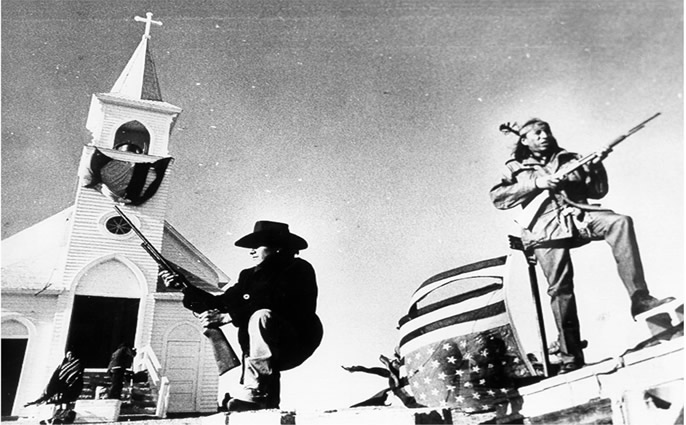
News clip:
Wounded Knee - Occupation '73
Bill Means Description
February 27, 1973
The Wounded Knee incident began February 27, 1973 when about 200 Oglala Lakota and 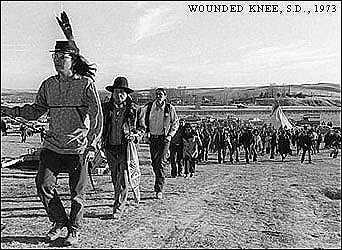 followers of the American Indian Movement (AIM) seized and occupied the town of Wounded Knee, South Dakota on the Pine Ridge Indian Reservation. The grassroots protest followed the failure of their effort to impeach the elected tribal president Richard Wilson, whom they accused of corruption and abuse of opponents; they also protested the United States government's failure to fulfill treaties with Indian peoples and demanded the reopening of treaty negotiations.
followers of the American Indian Movement (AIM) seized and occupied the town of Wounded Knee, South Dakota on the Pine Ridge Indian Reservation. The grassroots protest followed the failure of their effort to impeach the elected tribal president Richard Wilson, whom they accused of corruption and abuse of opponents; they also protested the United States government's failure to fulfill treaties with Indian peoples and demanded the reopening of treaty negotiations.
Oglala and AIM activists controlled the town for 73 days while the United States Marshals Service, Federal Bureau of Investigation agents and other law enforcement agencies 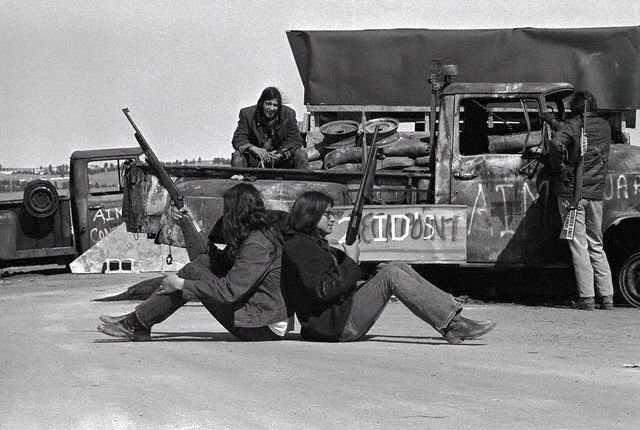 cordoned off the area. One of the Marshals involved in the operation was Tommy Robinson, later a United States Representative from Arkansas. The activists chose the site of the 1890 Wounded Knee Massacre for its symbolic value. Both sides were armed and shooting was frequent. An FBI agent was paralyzed from a gunshot wound early during the occupation, and later died from complications; a Cherokee and an Oglala Lakota were killed by shootings in April 1973. Ray Robinson, a civil rights activist who joined the protesters, disappeared during the events and is believed to have been murdered. Due to damage to the houses, the small community was not reoccupied until the 1990s.
cordoned off the area. One of the Marshals involved in the operation was Tommy Robinson, later a United States Representative from Arkansas. The activists chose the site of the 1890 Wounded Knee Massacre for its symbolic value. Both sides were armed and shooting was frequent. An FBI agent was paralyzed from a gunshot wound early during the occupation, and later died from complications; a Cherokee and an Oglala Lakota were killed by shootings in April 1973. Ray Robinson, a civil rights activist who joined the protesters, disappeared during the events and is believed to have been murdered. Due to damage to the houses, the small community was not reoccupied until the 1990s.
The occupation attracted wide media coverage, especially after the press accompanied 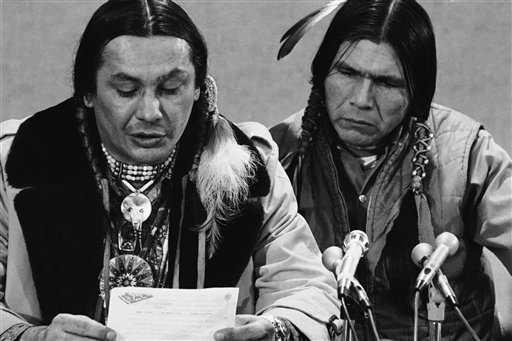 two US Senators from South Dakota to Wounded Knee. The events electrified American Indians, who were inspired by the sight of their people standing in defiance of the government which had so often failed them. Many Indian supporters traveled to Wounded Knee to join the protest. At the time there was widespread public sympathy for the goals of the occupation, as Americans were becoming more aware of longstanding issues of injustice related to American Indians. Afterward AIM leaders Dennis Banks and Russell Means were indicted on charges related to the events, but their 1974 case was dismissed by the federal court for prosecutorial misconduct, a decision upheld on appeal.
two US Senators from South Dakota to Wounded Knee. The events electrified American Indians, who were inspired by the sight of their people standing in defiance of the government which had so often failed them. Many Indian supporters traveled to Wounded Knee to join the protest. At the time there was widespread public sympathy for the goals of the occupation, as Americans were becoming more aware of longstanding issues of injustice related to American Indians. Afterward AIM leaders Dennis Banks and Russell Means were indicted on charges related to the events, but their 1974 case was dismissed by the federal court for prosecutorial misconduct, a decision upheld on appeal.
Stories from Wounded Knee, 1973
Video Description:
This video features an interview with one of the participants in the Wounded Knee incident of 1973. The interviewee describes how the takeover began with shots being fired between the Bureau of Indian Affairs and members of their caravan who had gone to Wounded Knee. The decision was made to block the roads to control the situation as the BIA and other federal officials were due to come out from Pine Ridge. The interviewee explains that the aim of the takeover was to draw attention to treaty issues and corruption on the reservation. They decided to stay and secure the perimeter, including the Wounded Knee trading post where they found weapons that they secured.
The situation became tense as law enforcement officers surrounded the group and occasional gunfire erupted. The interviewee explains that they decided to build bunkers in case of military attack and to put up resistance until they could explain their reasons for being there. The interviewee goes on to describe how Wounded Knee is a significant episode in American history, often seen as the last war between the cavalry and the US, where over 300 men, women, and children were killed and over 20 congressional medals of honor were awarded. The takeover sought to draw attention to the legacy of this historical event and to highlight the ongoing issues faced by Native Americans.
Stories from Wounded Knee, 1973 Part 2
Video Description:
The video discusses the three-part operation that was established in Wounded Knee, South Dakota during the American Indian Movement (AIM) occupation of the town in 1973. The operation consisted of a US post office, a trading post, and a museum, all interconnected. The video highlights how the trading post, owned by the Gildersleeve family, economically controlled the local Indian community, as residents would sell their beaded moccasins for $15-$20 at the trading post, only to see them sold for $100-$120 at the museum. Additionally, as the trading post owner also had control of the post office, they were able to take checks intended for rent and other income and cash them, giving change to the people who had written them. This was seen as a system of servitude, where the Indian community was controlled by the local trading post.
Stories from Wounded Knee, 1973 Part 4
The Wounded Knee Massacre occurred on December 29, 1890, near Wounded Knee Creek (Lakota: Čhaŋkpé Ópi Wakpála) on the Lakota Pine Ridge Indian Reservation in South Dakota, USA. It was the last battle of the American Indian Wars. On the day before, a detachment of the U.S. 7th Cavalry Regiment commanded by Major Samuel M. Whitside intercepted Spotted Elk's band of Miniconjou Lakota and 38 Hunkpapa Lakota near Porcupine Butte and escorted them five miles westward (8 km) to Wounded Knee Creek where they made camp.
The remainder of the 7th Cavalry Regiment arrived led by Colonel James Forsyth and surrounded the encampment supported by four Hotchkiss guns.
On the morning of December 29, the troops went into the camp to disarm the Lakota. One version of events claims that during the process of disarming the Lakota, a deaf tribesman named Black Coyote was reluctant to give up his rifle, claiming he had paid a lot for it. A scuffle over Black Coyote's rifle escalated and a shot was fired which resulted in the 7th Cavalry's opening fire indiscriminately from all sides, killing men, women, and children, as well as some of their own fellow troopers. Those few Lakota warriors who still had weapons began shooting back at the attacking troopers, who quickly suppressed the Lakota fire. The surviving Lakota fled, but U.S. cavalrymen pursued and killed many who were unarmed.
By the time it was over, at least 150 men, women, and children of the Lakota Sioux had been killed and 51 wounded (4 men, 47 women and children, some of whom died later); some estimates placed the number of dead at 300. Twenty-five troopers also died, and 39 were wounded (6 of the wounded would later die). It is believed that many were the victims of friendly fire, as the shooting took place at close range in chaotic conditions. At least twenty troopers were awarded the coveted Medal of Honor.
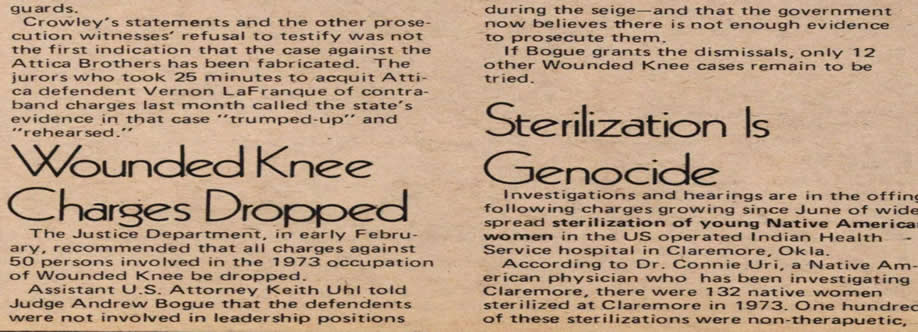
source:
http://en.wikipedia.org/wiki/Wounded_Knee_Massacre
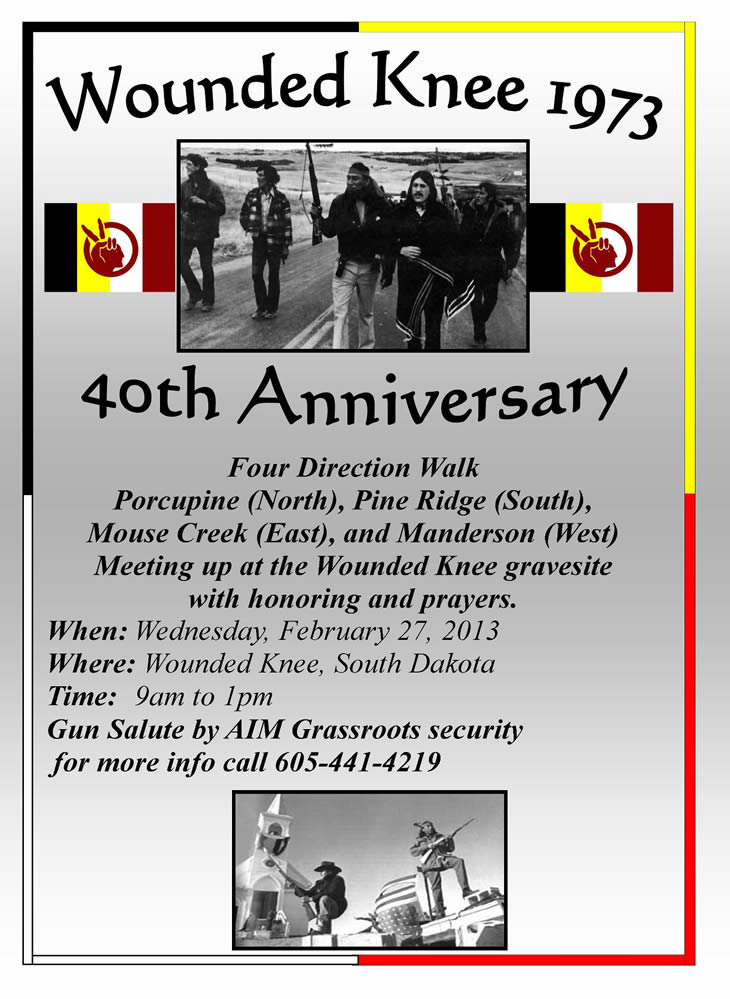
Redbone - Wounded Knee (HD)
Buddy Red Bow - Wounded Knee
Floyd Red Crow Westerman - Wounded Knee
DREAMS OF WOUNDED KNEE - BILL MILLER